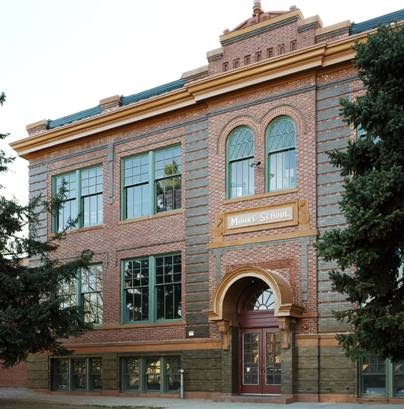History

Construction began on Corona School (later renamed Dora Moore School) in 1889. At that time, the population of Denver was 125,481. It cost $3,000 for the land at 9th Avenue and Corona Street. Robert S. Roeschlaub designed Corona School, as well as 28 other schools for the Denver Public Schools. The contract price was $71,000.
The school was supposed to open in January of 1890, but did not until the autumn of that year. The Denver Times reported that the total seating capacity was 700.
“Each classroom has a capacity of 60 students. The girls and boys each have a large lunchroom in the basement furnished with tables and benches. There are also four large rooms in which the janitor lives with his family.”
Many famous people have gone to Dora Moore School. Former Denver Mayors Quigg Newton and William H. McNichols attended Dora Moore together in the early 1920’s. Other famous alumni are Douglas Fairbanks, Sr., the big band leader Paul Whiteman, comedian Tim Allen, and Mamie Doud Eisenhower.
Timeline
- 1892: Ms. Dora M. Moore first taught at the Corona School. In September of the following year, she was named principal of the school. She was principal for 35 years. She lived at 1031 Emerson. Due to an injury, she retired in 1929. On September 2, 1929, the school was renamed Dora Moore in honor of her 37 years of service. She died at home on March 25, 1938, at the age of 83.
- 1897: An art league was formed. Over the next 28 years more than $6,000 was raised and expended at the school. A class graduating around 1920 donated the oak organ that now rests in the grand central hall.
- 1903: A group of mothers presented Ms. Moore with funds for a European vacation.
- 1907: A system of student government was instituted.
- 1909: A building permit was issued for an addition to Corona School. David W. Dryden designed this addition, as well as other DPS buildings. It was built at a cost of around $60,000.
- 1921: The 7th and 8th graders moved to the newly opened Morey Junior High.
- 1931: Seven lots adjacent to the school were brought for $40,000 to be used for the playground. The school now occupied the whole block, except for two houses. Enrollment was 1,159 students.
- 1950: In the 1950’s the lunchroom and kitchen facilities were built in the basement. After that construction, the janitor no longer lived in the basement.
- 1974: On October 14, 1974, the Student Council began a process that led to Dora Moore being designated a city landmark. This led to a renovation/remodeling project that was finished in 1978 at a cost of over $600,000.
- 1991: In 1991, a bond issue election resulted in the addition of a new gymnasium, a connector building, remodeling of the cafeteria, and improvements in many classrooms. It was part of three projects that improved the school and grounds making it the showplace of Capitol Hill. These three projects were-the additions to and remodeling of the school, the 9th Ave. streetscape project, and turning the playground into a neighborhood park. Over $3,000,000 was spent on these projects.
- 1995: In the summer of 1995 with the help of a grant from the State Historical Society, the stained glass windows on the north side of the 1889 building were restored.
- 2003: In the late summer of 2003, the exterior of the building was stabilized and restored at a cost of nearly $1.8 million. An additional $200,000 from the State Historical Society was added. Nearly 12,000 bricks were replaced with vintage bricks. Man-made stones were cast to match in color, texture, and aging to replace stones that needed to be replaced. Stained glass windows were restored on the west, south, and east side of the Roeschlaub building. All of the windows in both buildings were restored.